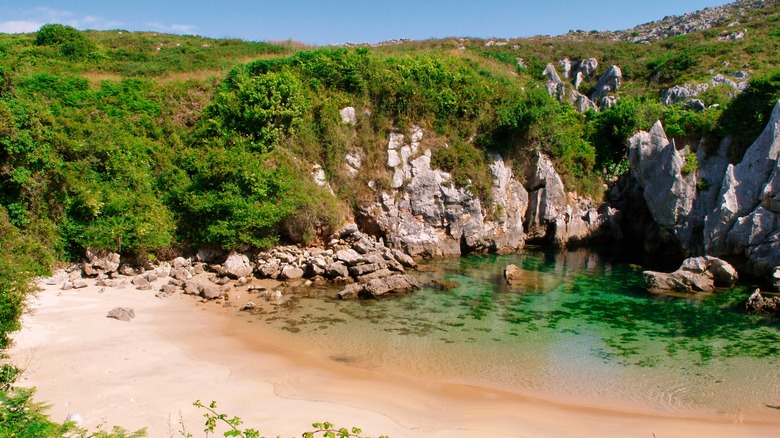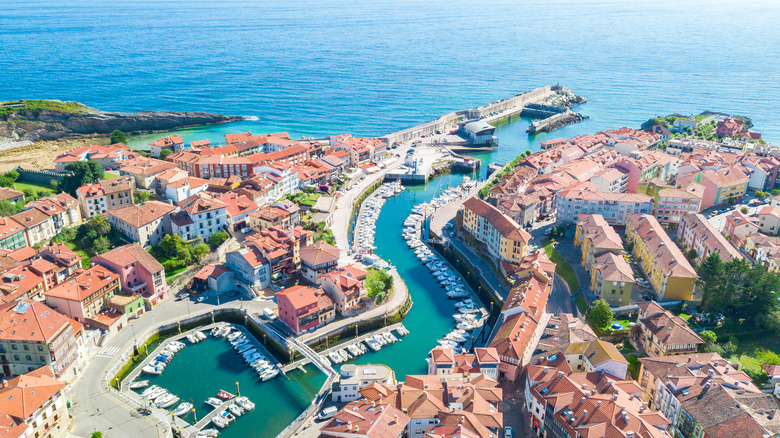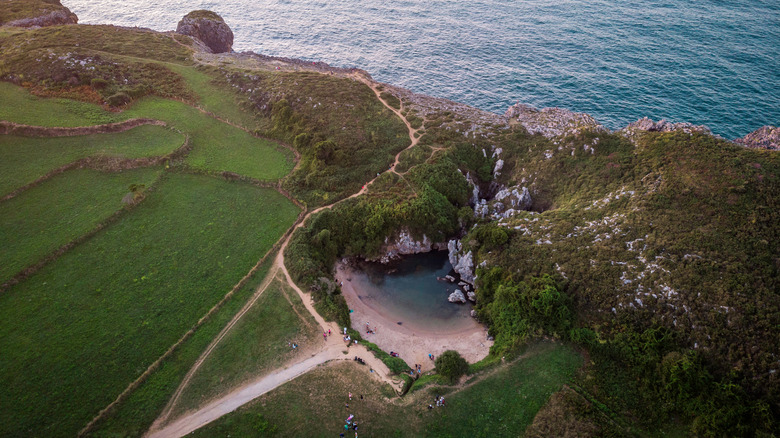Europe offers a wide array of beaches, each with unique characteristics, from the sun-kissed Mediterranean to the rugged Atlantic coastlines, serene Nordic and Baltic sands, warm Black Sea beaches, secret tropical islands, and distinctive pebble waterfronts. However, amidst all these diverse shores lies a noteworthy spot that claims the title of the world’s smallest beach: Playa de Gulpiyuri, or Gulpiyuri Beach in Spain.
Located in the region of Asturias, this tiny beach is only 130 feet long, situated inland within a grassy meadow, approximately 330 feet from the coastline. Gulpiyuri Beach is a flooded sinkhole with a sandy bottom connected to the sea through underground tunnels carved over thousands of years by water from the Bay of Biscay. Gentle waves surface from underneath, further enhancing its peaceful atmosphere. No wonder why its name translates to “water circle” in Spanish — it’s a beach without a sea! Although its shape is more shell-like than circular. As a hidden gem, it offers a beach experience that stands out in Europe for its intimate setting.
Despite its small size, Gulpiyuri Beach has been declared a Natural Monument by the Regional Network of Protected Natural Areas. This designation helps protect its fragile environment and maintain its untouched beauty. The secluded location and the unusual way the beach is fed by the sea make it a must-visit for nature lovers searching for something extraordinary. If you’re looking for beach bars, comfortable amenities, and sunchairs with umbrellas, Playa de Gulpiyuri is not the place for you.
Planning your visit to Playa de Gulpiyuri

If you want to add this underrated destination in Spain to your bucket list, your first step would be to fly into the nearest airport, Asturias (OVD). If you already happen to be around Bilbao, ALSA offers a three-and-a-half-hour bus ride to Naves (the closest municipality to Gulpiyuri Beach) four times a day. From there, Playa de Gulpiyuri is accessible via a short trail, about half a mile to a mile, which is well-connected by road to the larger towns of Llanes and Ribadesella. Keep in mind that the beach is only accessible on foot and there are no amenities, no parking, nada!
Ideally, the best time to visit is during the summer when the weather in northern Spain is most favorable. However, aim to arrive early before all the crowds to experience the beach at its quietest. During the high season in July and August, thousands of locals and international travelers visit Gulpiyuri Beach, and considering how small it is, you won’t regret being an early bird. Upon arrival, you will be greeted by the surreal sight of clear turquoise water and golden sand. The water level at Gulpiyuri varies with the tides, offering different experiences throughout the day. At a high tide of 10 feet, the beach is perfect for paddling and swimming, while the low tide at 3 feet reveals the intricate rock formations within and more room to bask in the sun.
Activities and attractions nearby

Although the beach is the main attraction, the surrounding region of Asturias offers plenty to see and do. The principality is known for its stunning landscapes, which include rocky coastlines, mountains, and green valleys. Nearby towns such as Oviedo, Gijón, and Cudillerowill delight you with their quaint atmosphere, religious sites, and ancient architecture, offering a rich cultural experience alongside the natural beauty of the region.
Furthermore, only 20 minutes away from Gulpiyuri Beach lies the historic town of Llanes, with its medieval cobblestone streets and heritage buildings. Take a walk on the Paseo de San Pedro, a cliff path running down to the port with beautiful views of the city and sea. Within Llanes, you will discover 12th and 13th-century beauties like the Basilica of Santa María del Conceyu, the Llanes Castle Tower, and Gastañaga Palace.
Those looking for more adventure can visit one of the best national parks in Spain, Picos de Europa National Park or Redes Natural Park, for an active, nature-filled day trip. At Picos de Europa, expect some sky-high hiking on the Torre Cerredo peak, which towers at nearly 9,000 feet. There are also two beautiful mountain lakes for a refreshing dip: Lake Enol and Lake Ercina. Redes, a UNESCO Biosphere Reserve, offers 42 hiking trails, beautiful mountain lodges, and bird-watching opportunities amidst breathtaking scenery. So, are you ready for a big adventure to the world’s smallest beach?

